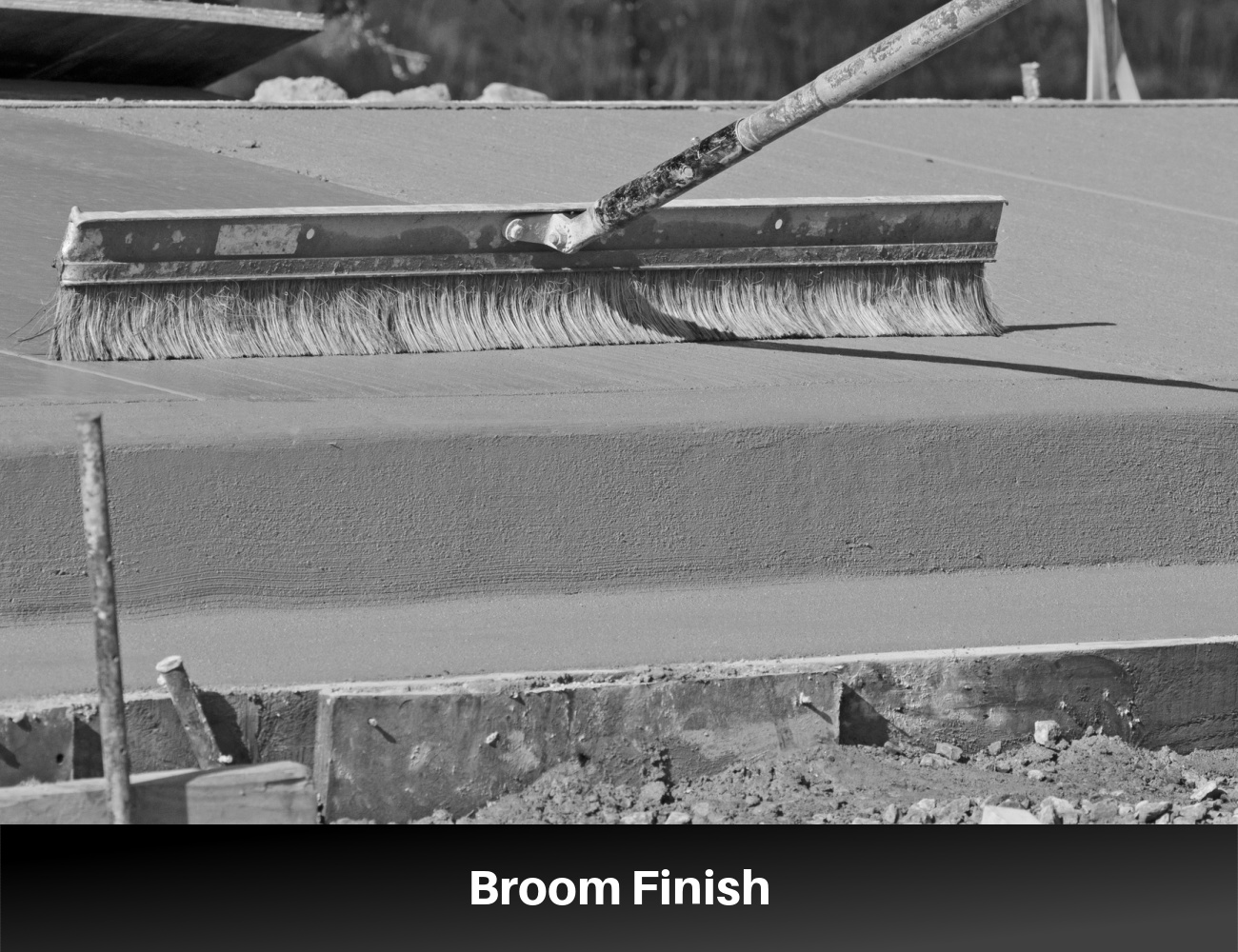Concrete finishes are a way that builders and designers can transform ordinary concrete surfaces into visually pleasing, functional, and durable spaces. From smooth trowel finishes that are sophisticated and sleek to textured surfaces that provide enhanced grip, there are concrete finish types to suit every application. These finishes do not just improve the aesthetics of concrete but also contribute to the longevity and maintenance of concrete surfaces.
Concrete Finishes and Their Pros and Cons
There are so many concrete finish options available, the key is selecting the right one for the project. This is where understanding the advantages and disadvantages of each type is essential.
Smooth Trowel Finish
A smooth trowel finish involves builders using a trowel, which is a steel blade, to create a smooth and glossy finish on the concrete.
Pros:
- Aesthetically Pleasing – This finish provides a clean and sleek look that complements contemporary and minimalist styles.
- Reflective Surface – This surface reflects light, so they look lustrous and glossy and brighten interior spaces.
- Easy to Clean – The smooth surface is easy to wipe down and keep clean.
- Durable – A properly installed trowel-finished floor is durable and long-lasting. It can resist heavy use, abrasion, and wear, so it works well in commercial as well as residential settings.
Cons:
- Slippery – The smooth surfaces of trowel-finished floors are slippery when they get wet, so they can pose a safety risk in areas exposed to water.
- Cost – This concrete finish requires skill and expertise to accomplish. If you need to hire a professional, it will increase the cost of the floor.
- Noticeable Imperfections – The smooth surface of this floor will show any imperfections such as cracks or blemishes more readily than textured surfaces.
- Time-Consuming – This floor finish requires multiple steps and sufficient curing time.
Broom Finish
Broom-finished concrete floors are a popular option. For this surface, builders create a textured surface by using a broom to create small grooves on the face of the concrete.
Pros:
- Slip-Resistant – The textured grooves of the broom finish provide traction, even in areas with water. This makes it a safer option in areas like pool decks or sidewalks where slipping is a concern.
- Cost-Effective – This is an easy finish to complete as it requires minimal tools and labor, so this finish is ideal for large concrete areas.
- Easy to Apply – A broom finish requires less expertise than other finishes, so it can be accomplished by many contractors without specialized tools or training.
- Durable – This is a durable finish as the grooves help to minimize wear and withstand heavy foot traffic.
Cons:
- Limited Aesthetics – The broom finish has a utilitarian rather than a decorative aesthetic, so it cannot be applied as widely as other finish options.
- Rough Texture – While this finish does provide slip resistance, it is rough underfoot, so it may not be desirable in places where people are barefoot.
- Difficult to Fix or Modify – The finish of a broom surface is distinct, so it is difficult to repair or modify after the surface has been completed without a noticeable difference.
Exposed Aggregate Finish
This finish exposes the aggregates, such as pebbles or stones, by removing the top layer of cement to create a varied and textured surface.
Pros:
- Aesthetic Appeal – Contractors use various materials as the aggregates including shells, glass, and decorative stone, so this can provide a distinct visual and aesthetic interest to decorative spaces.
- Slip-Resistance – The exposed aggregate surface creates a slip-resistant finish that works well in places with moisture.
- Durability – This surface is durable and resistant to wear as aggregates are some of the strongest materials in concrete. This makes this finish suitable for high-traffic areas.
- Low Maintenance – The exposed aggregates hide dirt, stains, and small flaws which make it easier to maintain than smooth concrete surfaces.
Cons:
- Cost – The extra step of exposing the aggregates on this surface makes it more expensive than plain concrete finishes. The cost will also increase with more expensive aggregates.
- Limited Design Control – The selection of aggregates creates the pattern on this surface, so the design options are limited.
- Potential Discomfort – Depending on the size, type, and orientation of the aggregates, these can create a rough surface that is uncomfortable for bare feet.
- Difficult Repairs or Modifications – Once this surface is complete, it is difficult to modify or repair the surface without visible patches.
Stamped Concrete Finish
Stamped concrete is imprinted with decorative patterns or textures so that it resembles other materials like slate, wood, or bricks.
- Pros
- Versatile Aesthetics – This finish offers a variety of design options for different aesthetic styles. You can use this finish to customize your concrete to your own taste.
- Cost-Effective Alternative – Concrete is a less expensive material than slate, bricks, or stone, so it is less expensive to use it to mimic these materials.
- Durable – When installed properly, stamped concrete provides a durable surface for high-traffic areas.
- Low Maintenance – Once it has been sealed, stamped concrete is easy to maintain with occasional cleaning and resealing.
Cons:
- Non-Uniform Appearance – Achieving a uniform appearance on the surface of stamped concrete can be challenging in large areas. You can minimize this issue by employing a knowledgeable and experienced contractor.
- Potential for Cracking – Like all concrete surfaces, they are susceptible to cracking if they are not properly installed onto a stable subbase or if they are exposed to freeze-thaw cycles.
- Slippery – These surfaces can be slippery when exposed to moisture, especially if they have a glossy sealer.
- Limited Repair – Achieving a seamless repair once the surface is complete is difficult and will be noticeable.
- Initial Cost – This finish requires skilled labor and expertise, so it is more costly to complete than plain concrete finishes.
Salt Concrete Finish
This finish involves placing salt crystals into freshly poured concrete and then washing them away once the concrete has cured.
Pros:
- Aesthetic Appeal – This finish option presents a fine textured and mottled appearance which can give a stone-like or weathered effect.
- Slip-Resistance – This textured finish offers slip-resistance
- Cost-Effective – A salt finish is a much less complex finish option than other decorative options, so it is less expensive to achieve.
- Durability – This is a durable concrete finish option that hides minor imperfections well.
Cons:
- Limited Options – The surface pattern created by salt is less customizable than decorative options like stamped or stained concrete.
- Salt Residue – Salt residue may last even after the surface has been initially washed and require additional cleaning.
- Uneven Texture – Achieving an even texture for the entire surface is difficult, especially for large areas.
Integral Color Concrete Finish
For integral color finishes, contractors add dye or pigments to the concrete mix, so that there is color throughout the entire mixture.
Pros:
- Vibrant and Consistent Color – There is a wide range of colors for this option. Because the dye is added to the fresh concrete, there is consistent color throughout the entire mix. Even if the surface is chipped or worn, it will look the same.
- Long-Lasting Color – Because the color runs through the material, it is more resistant to UV damage and will retain its color.
- Design Flexibility – You can customize the color and intensity of the concrete, so you can achieve the look that you want.
- Low Maintenance – This surface type requires minimal maintenance. Regular cleaning and occasional sealing are enough to keep it looking good.
Cons:
- Limited Modifications – Unlike surface coloring options, once the concrete is mixed and poured for integral color finishes, it is difficult to modify.
- High Initial Cost – This is a more costly finish than plain concrete finish options as it requires skill and expertise and the additional cost of dye.
- Possible Color Inconsistency – Contractors who implement this finish strive for consistency, but it is not always achieved due to the concrete mix, curing complications, or application.
- Difficult Repairs – Matching the concrete color for repairs is difficult, so repairs will often be visible.
Polished Concrete Finish
Polished concrete finishes require grinding and polishing the concrete to create a smooth surface.
Pros:
- Aesthetic Appeal – Polished concrete has a sleek and elegant style that helps promote a modern and high-end appearance.
- Durability – Polishing the surface of concrete creates a dense surface that makes it resistant to wear or chipping and flaking.
- Low Maintenance – The smooth and dense polished surface is easy to clean with minimal sweeping and mopping.
- Long-Term Cost-Effectiveness – Because this is a durable surface, it does not require replacement over time like carpet or wood, so you will save money in the long run.
Cons:
- Reflective and Slippery Surface – Polishing concrete can create a reflective surface which might produce glares in sunny rooms. This is also an extremely slippery surface when it is exposed to water, so it is not suitable for bathrooms or pool areas.
- Cold and Hard Surface – The cold surface of polished concrete is not a good option to create cozy and comfortable spaces.
- Limited Repair – Seamless repairs on the polished concrete surface are difficult to achieve, so they may differ in texture or sheen level.
Sandblasted Concrete Finish
Contractors create sandblasted concrete finishes using high-powered air or sand or other abrasive material to create a rough textured look.
Pros:
- Slip Resistance – The textured surface of sandblasted finishes provides good traction even in wet places.
- Aesthetic Appeal – This finish adds depth and character to surfaces that are ideal for a rustic or industrial look.
- Conceals Imperfections – The rough surface of this texture conceals small imperfections like cracks and chips better than smooth concrete finishes.
Cons:
- Surface Roughness – This rough surface is ideal for slip resistance, but it can be hard on bare feet.
- Difficult to Clean – The uneven surface of this finish creates divots that make cleaning it more difficult than smooth surfaces.
- Potential for Uneven Finish – Achieving an even texture over the whole surface can be difficult as it requires no variation in pressure and technique. This is especially true if it is a large surface area.














